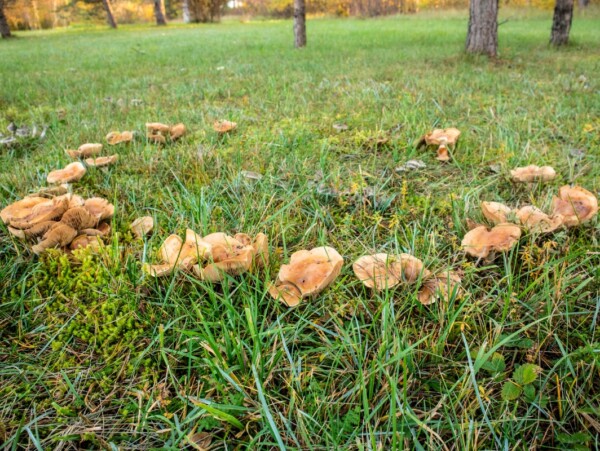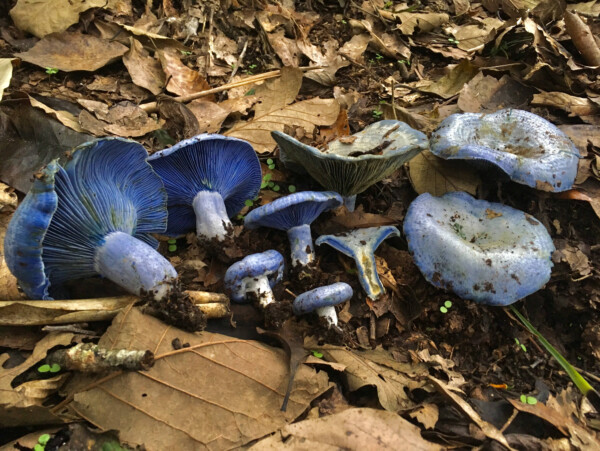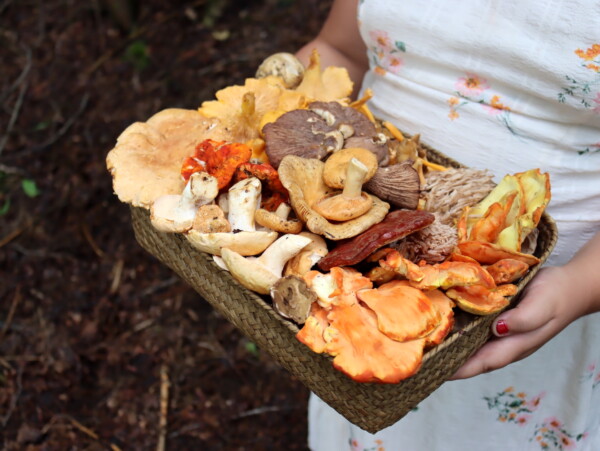Affiliate disclosure: This post may contain affiliate links. Please see our Privacy Policy.
Parasol Mushrooms (Macrolepiota & Chlorophyllum Sp.) are classic summertime edible wild mushrooms available all across the US and Europe. They’re especially popular in French cooking, where they’re often breaded and fried, but they’re delicious in any dish where you’d normally enjoy mushrooms.
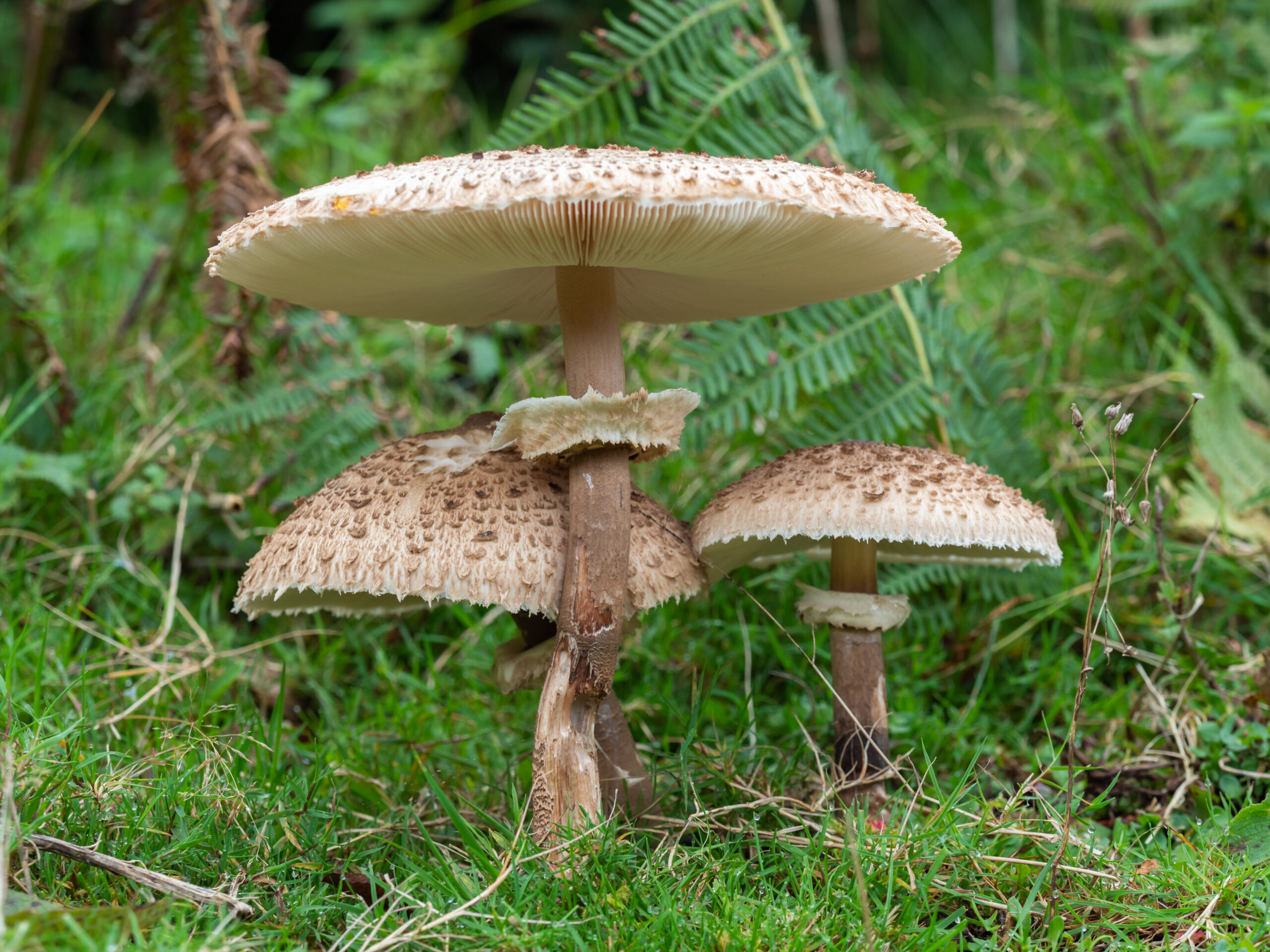
This article was written by Timo Mendez, a freelance writer and amateur mycologist who has foraged wild mushrooms all over the world.
In France, the Parasol Mushroom (Macrolepiota procera) is known by some as the “Mushroom With A Thousand Names.” Across the country, it goes by coulemelle (little column), grizzette (from gray), fusée (rocket), lépiote élevée (elevated lepiota), mort-de-froid (frozen-to-death), and other creative names.
The reasons for this are probably diverse, but one thing is for sure, it’s a delicious and highly cherished mushroom. Whether you eat them breaded, grilled, or as part of a sautée, this is a mushroom that pairs well with almost anything. This mushroom is adored all across Europe, even in the parts that have little mushroom culture.
This mushroom is also very emblematic. It is large, stands tall, and is easily recognized from afar. Not to mention, it grows just about everywhere: pastures, woodlands, forests, edges, gardens, and anywhere with rich, fertile soil that’s high in organic matter.
Before moving forward, I should specify that “Parasol Mushroom” is often used loosely to describe a number of different mushroom species. This includes those in the genus Macrolepiota and a separate group of mushrooms known as the “Shaggy Parasols” (Chlorophyllum sect. rhacodes). While they all have similar morphologies, they are distinct. We’ll discuss this in depth later in the text.
Its worth mentioning that this mushroom does have toxic lookalikes. While they aren’t too tough to differentiate, I highly encourage you to use caution with this species, especially if you’re new to mushroom identification. This is not a mushroom you want to have overconfidence in. After all, the lookalike known as “The Green Spored Parasol” (Chlorophyllum molybdites) is one of the top causes of mushroom intoxication around the world (although its rarely mortal).
Don’t worry though; with a careful eye for detail and proper precaution, these can be safe for picking. Plus, you’re already on the right path to enjoying these mushrooms if you’re reading this article.
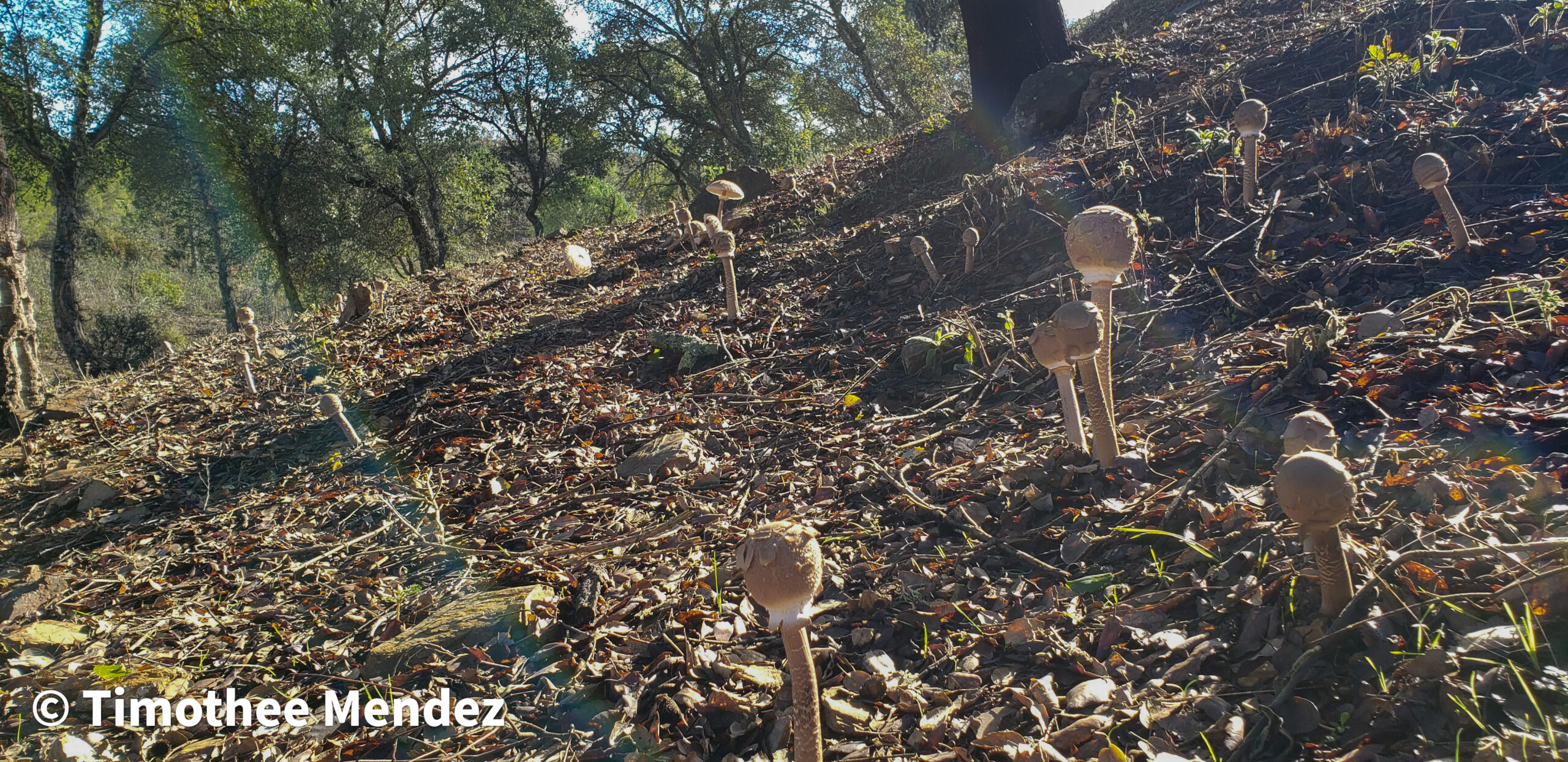
Natural History Of Parasol Mushrooms
Parasol Mushrooms are soil-dwelling decomposers that occur in meadows, woodlands, forest edges, and occasionally within forests themselves. They tend to grow in fertile soils that are high in nitrogen and have lots of organic matter. They are also particularly fond of human-managed landscapes, be they grazing lands, gardens, lawns, or even small pockets of soil within urban areas.
Because of this, one should use caution when picking in areas that may have contamination. Many studies have been released showing that this species of mushroom can and does bioaccumulate heavy metals (1, 2, 3)
As a decomposer, these mushrooms play an important role in nutrient cycling by releasing nutrients and minerals locked away inside organic debris. They always fruit directly from the ground and never from trunks, stumps, or any woody debris. Occasionally, these mushrooms are known to grow in a circular patch known as a fairy ring.
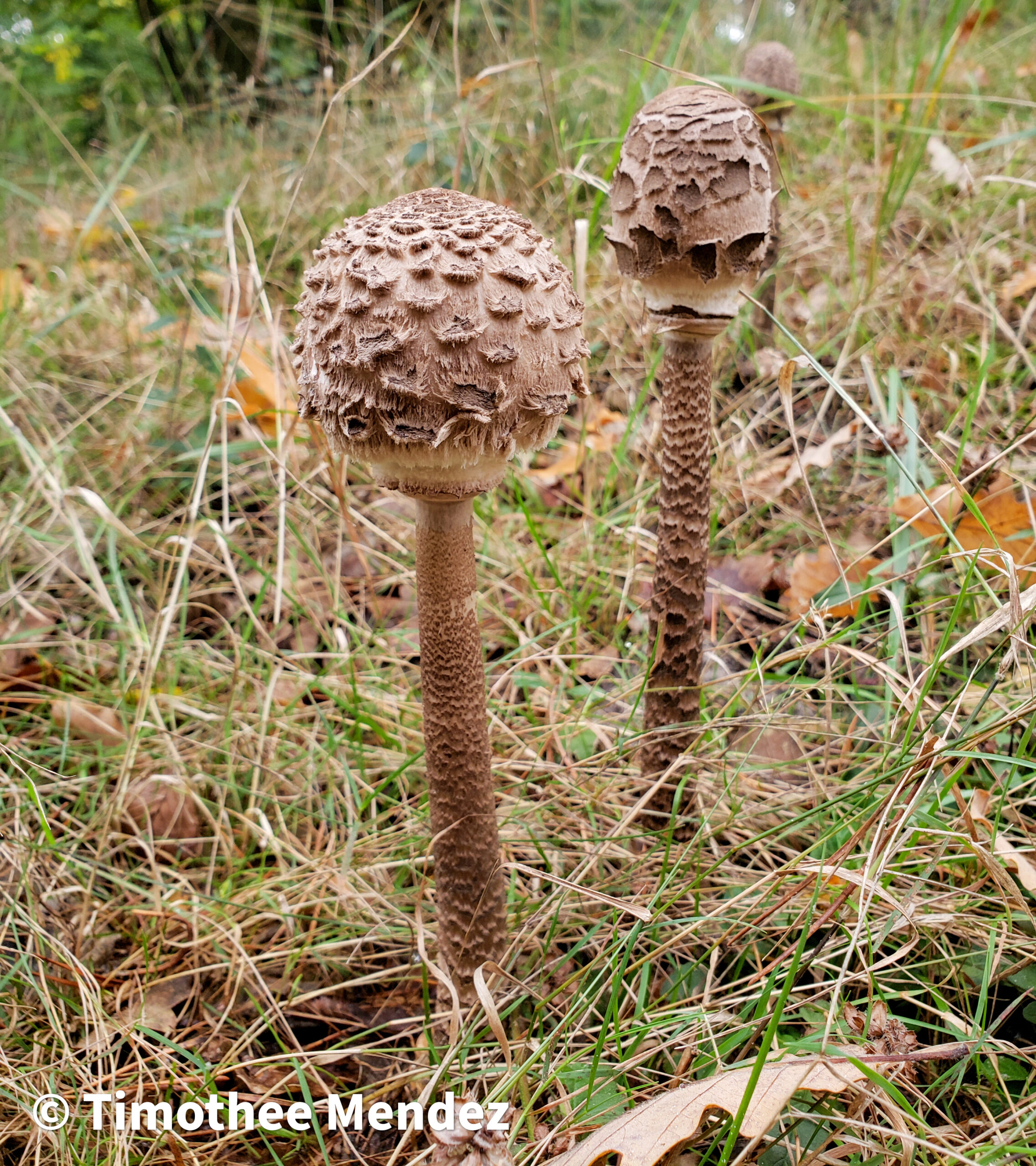
Regarding the diversity of Parasol mushrooms, there are two main groups:
- The True Parasol Mushrooms (Macrolepiota sp.): These are the most cherished and belong to the genus Macrolepiota with the species Macrolepiota procera being the most well-known. All are edible, and most look pretty similar. It is likely that North American Macrolepiota procera may be described as a new species eventually. While they occur in most parts of the world, they are pretty much absent from the western US and Canada.
- The Shaggy Parasols (Chlorophyllum sect. rhacodes): There are at least 3 species of Shaggy Parasols which a readily enjoyed around the world. These are in the genus Chlorophyllum and section rhacodes. Use caution because there are several toxic species in the genus Chlorophyllum and even the edible ones are known to cause gastric upset in some individuals.
How To Identify Parasol Mushrooms
Parasol mushrooms (Macrolepiota procera) are large, white to dark-brown colored, and umbrella-shaped (hence, parasol). The mushrooms can be exceptionally large, with caps up to 30 or 40 cm in diameter! Mushrooms are rarely smaller than 10 cm, so that’s the first thing to consider if you think you’ve found a Parasol.
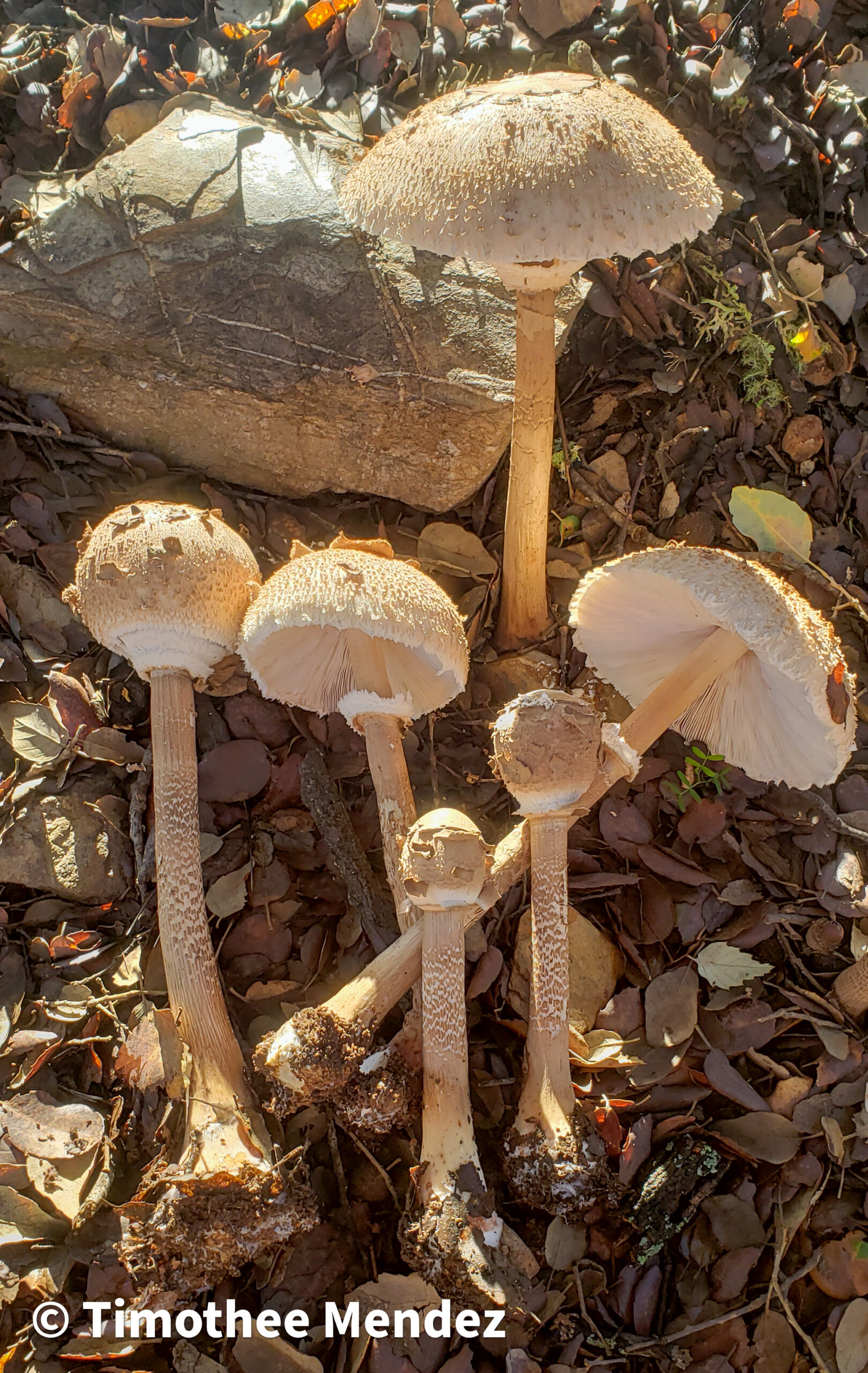
True Parasol Mushrooms (Macrolepiota procera)
These are the identification characteristics of True Parasol Mushrooms:
Cap
When young, the cap is spherical or egg-shaped and unfurls into a saucer-shape as it matures. The cap’s surface is covered in brown scales, which are organized radially and usually fade towards the margin of the cap.
The cap color ranges from white to dark brown, depending on the patch and age of the mushrooms. They tend to be darker when the caps are still immature. The center of the cap forms a distinctive nipple and is typically the darkest part.
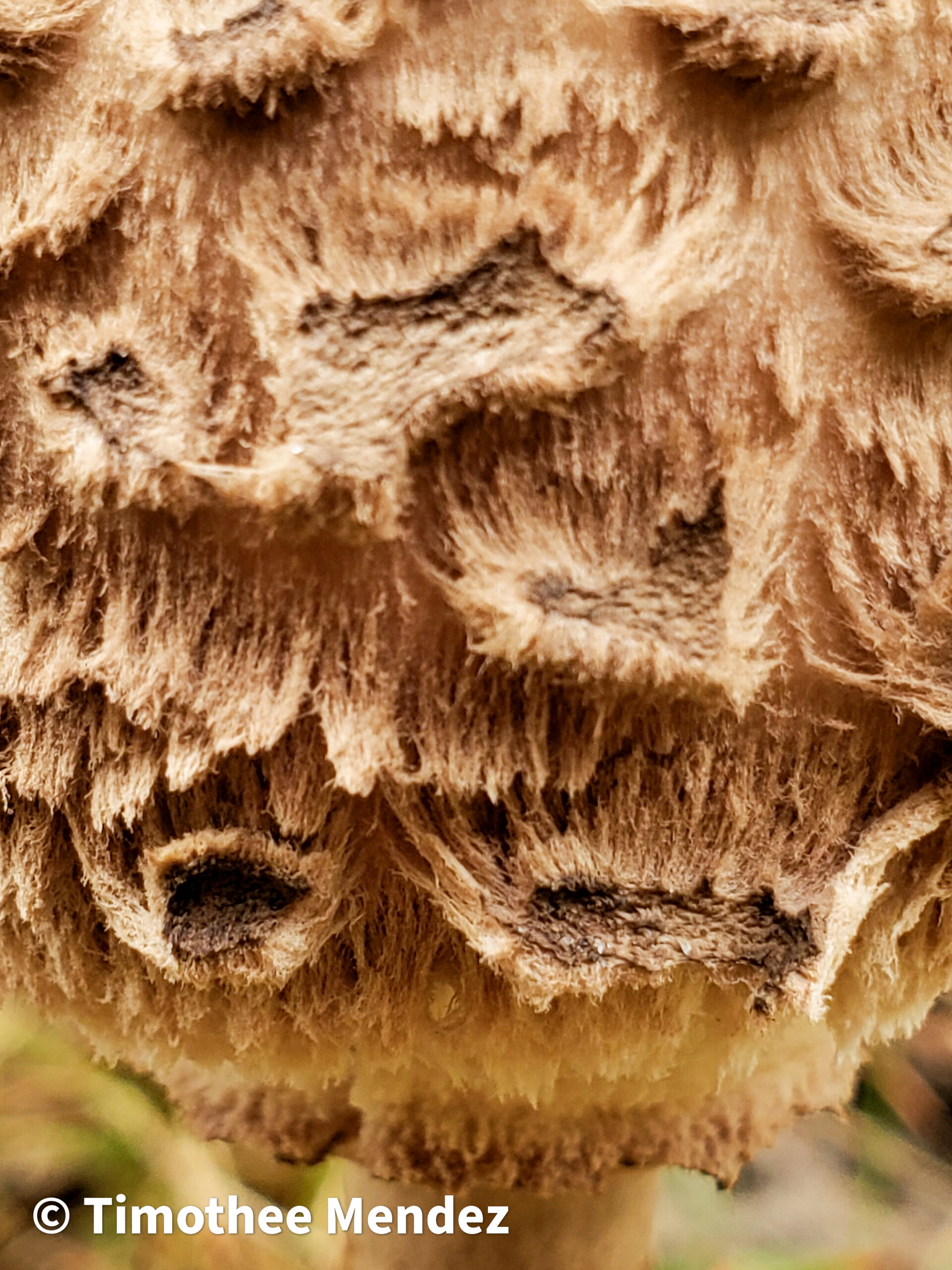
Gills
The gills are white to rose-colored and very close together.
The spore print they release is white and is occasionally observed near mature mushrooms.
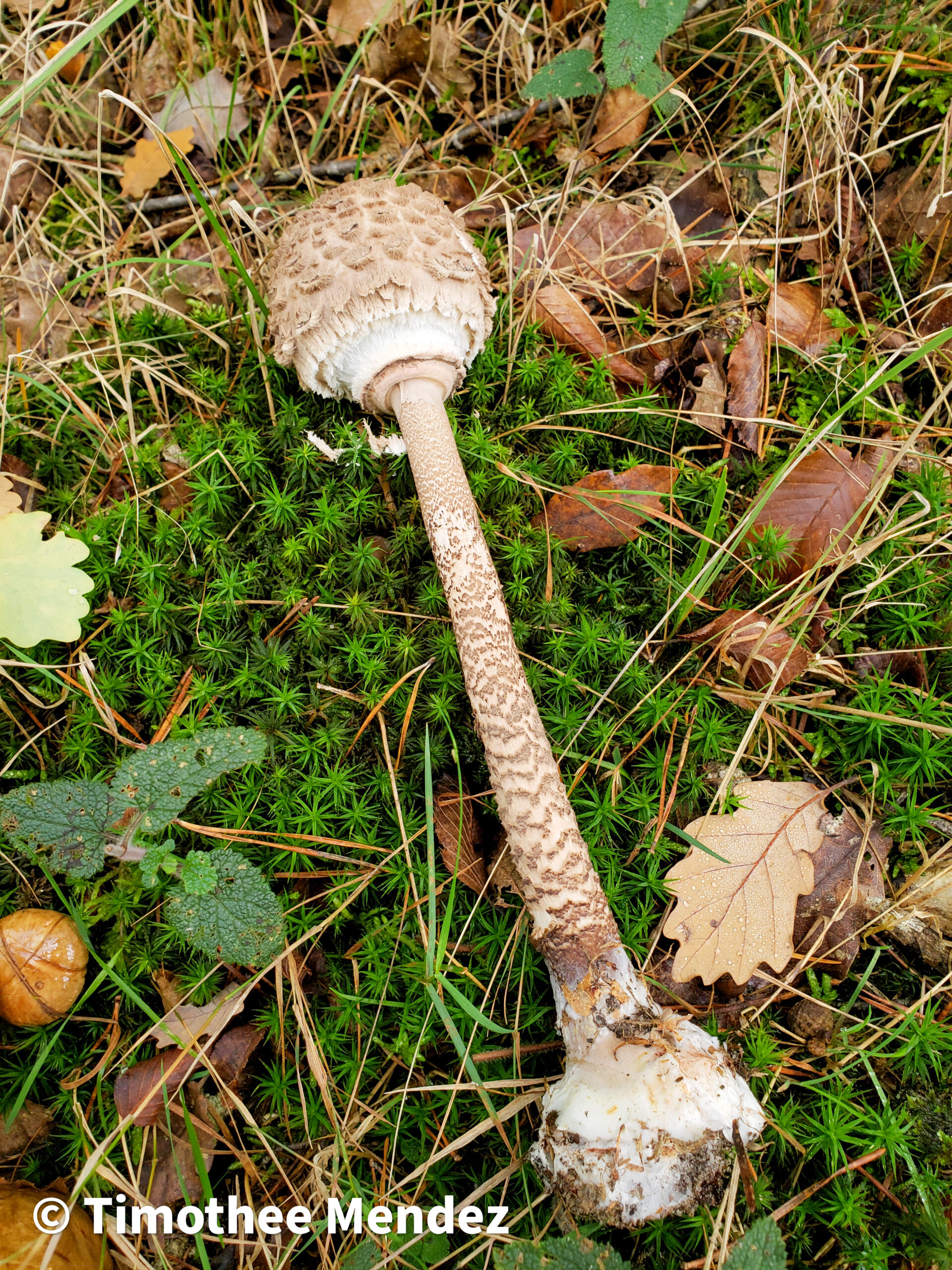
Stem
The stem has a ring or “annulus” that can be easily detached and moved up and down the stem. This is a diagnostic feature for Macrolepiota. The stem itself is white to brown and adorned with a snake-skin pattern that is also indicative of this genus.
There is no volva, or “egg” attached to the bottom of the stem, as is the case with Amanitas.

Smell and Taste
When fresh, the smell and taste are pleasant but relatively mild. There are no strong odors or flavors like those found in other mushrooms.
One should also consider that other species in the Macrolepiota genus look very similar. There are about 20 species, the most common being M. prominens, M. zeyheri (White Parasol) M. mastoidea (Slender Parasol), M. clelandii (Graceful Parasol), M. excoriata (frayed parasol), M. rhodosperma, and M. konradii. These are all edible. The detachable ring and snake-like pattern on the stem are diagnostic features of this genus. Be aware that there are some toxic species that were previously described as Macrolepiota that have now been moved to Chlorophyllum, for example, the toxic Chlorophyllum neomastoidea from Asia (Vellinga, 2003).
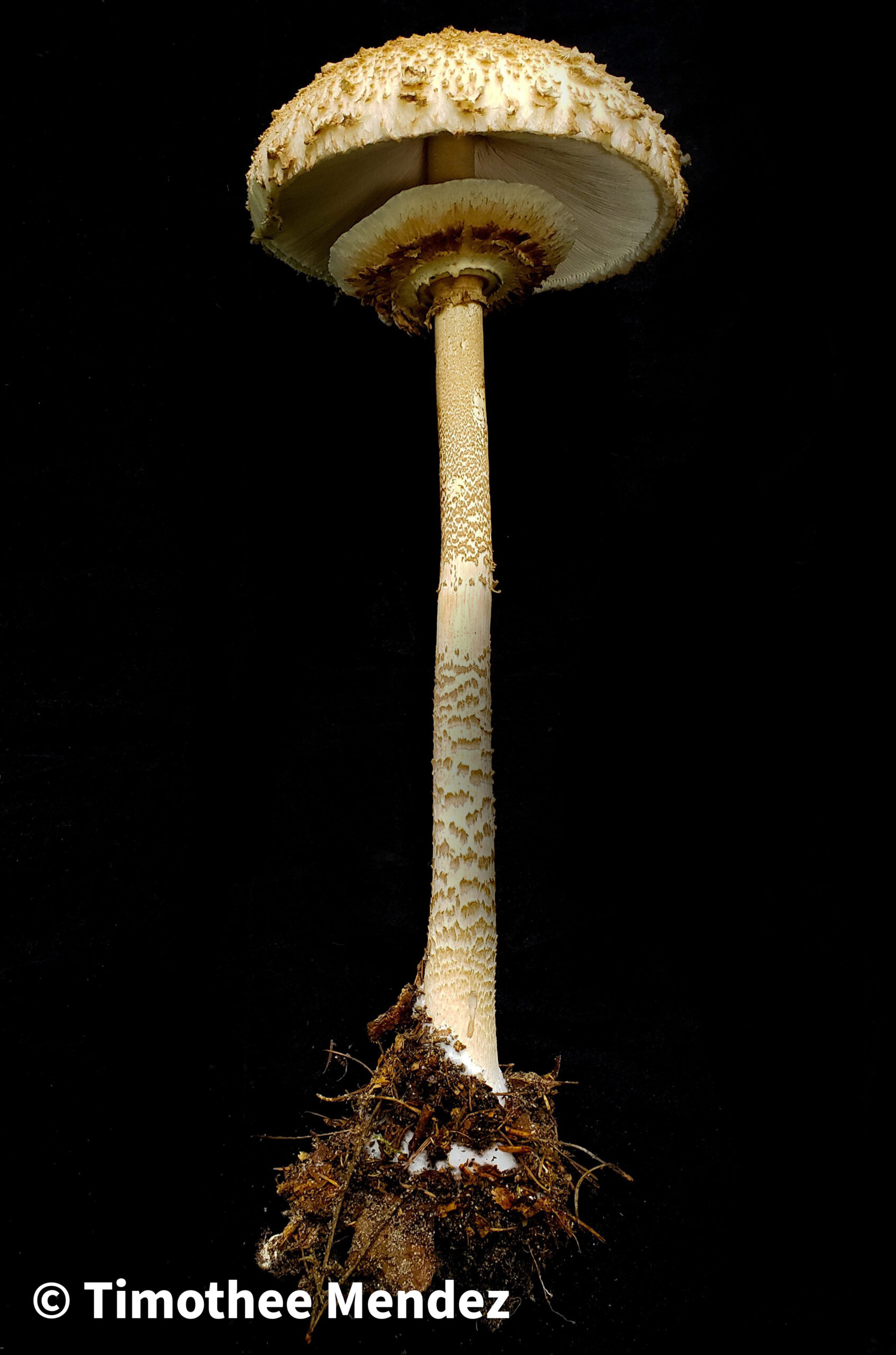
Identification Checklist For Parasol Mushrooms (Macrolepiota)
- Parasol mushrooms are large and rarely smaller than 10 cm.
- When young, the cap is spherical or egg-shaped and unfurls into a saucer shape.
- The cap is nippled and brown in its center. It has radially arranged brown scales that gradually fade away towards the margin.
- The gills are free and close together; they are primarily white but may have a slight pink hue.
- The stem features a detachable ring, or “annulus,” that can be moved up and down the stem.
- The stem has a distinctive snake-skin pattern, which differentiates it from Chlorophyllum and other lookalikes.
- There is no cottony volva or bulbous base
Shaggy Parasols (Chlorophyllum sect. rhacodes)
Aside from the true Parasols in the genus Macrolepota, there are also the edible “Shaggy Parasols” that are in the genus Chlorophyllum and the sub-classification, section rhacodes.
This includes species such as Chlorophyllum olivieri, Chlorophyllum brunneum, and Chlorophyllum rhacodes. Remember, not all chlorophyllum is edible, but the ones in section rhacodes are!
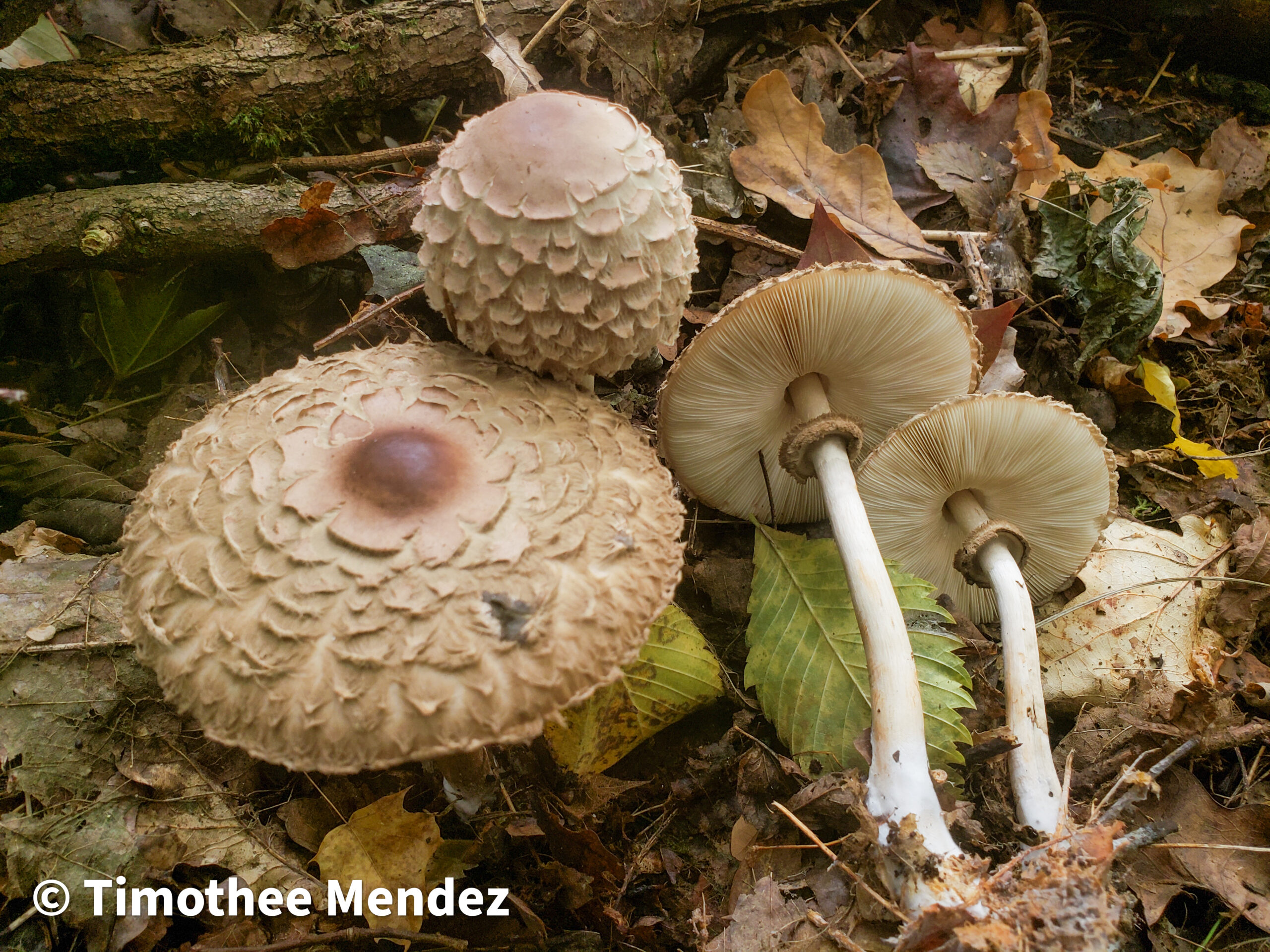
Compared to Macrolepiota, these mushrooms are typically lighter in color, with more distinct shaggy scales, and they tend to be a bit smaller. Yet, the simplest way to distinguish these from true parasols is by the smooth stem, which lacks the “snake-like” pattern found on Macrolepiota.
Some people have trouble digesting Chlorophyllum species, so it’s recommended to only consume small portions when trying for the first time.
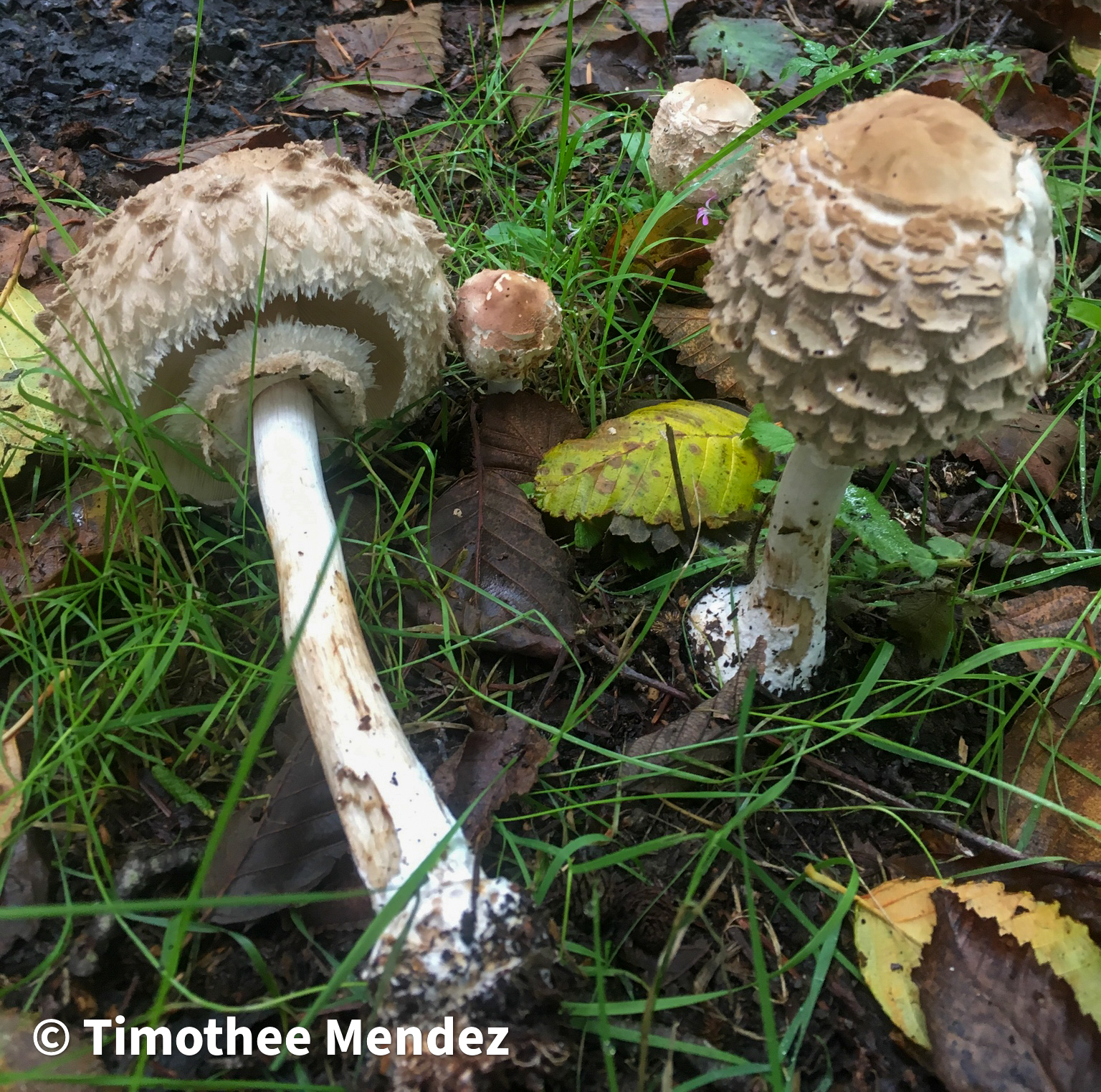
Parasol Mushroom Lookalikes
Parasol mushrooms have a number of look-alikes:
Green Spored Parasol (Chlorophyllum molybdites)
This is the lookalike you’re going to want to most careful of, especially if you’re in North America (it’s less common in Europe).
In the Americas, this mushroom tends to be more common than edible Parasols.
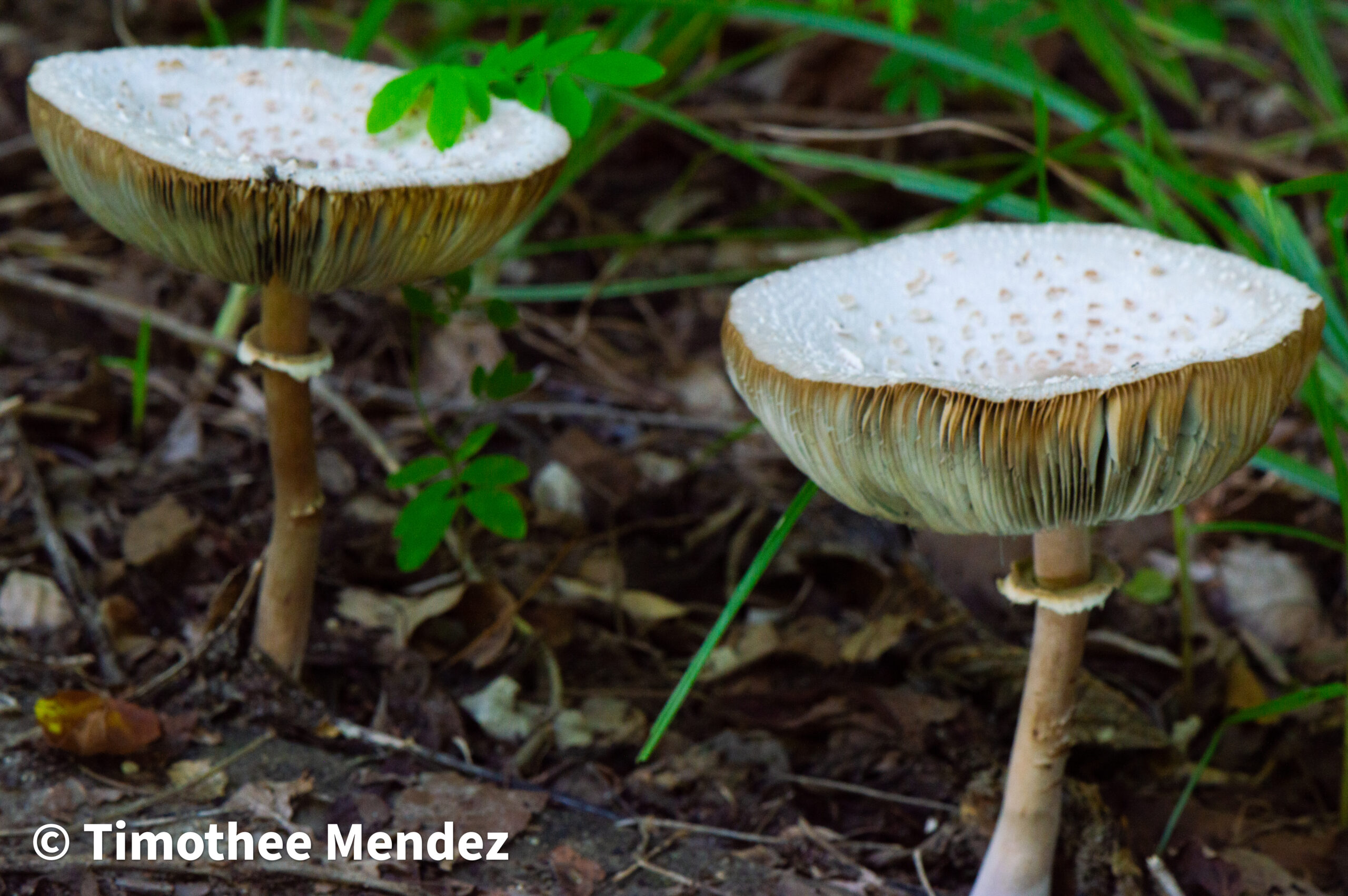
The biggest distinguishing features of this species are the green-blue gills and spores. It is one of the only mushrooms with green spores! If you have any doubts, look up how to do a spore print.
Edible parasols have a white spore print.
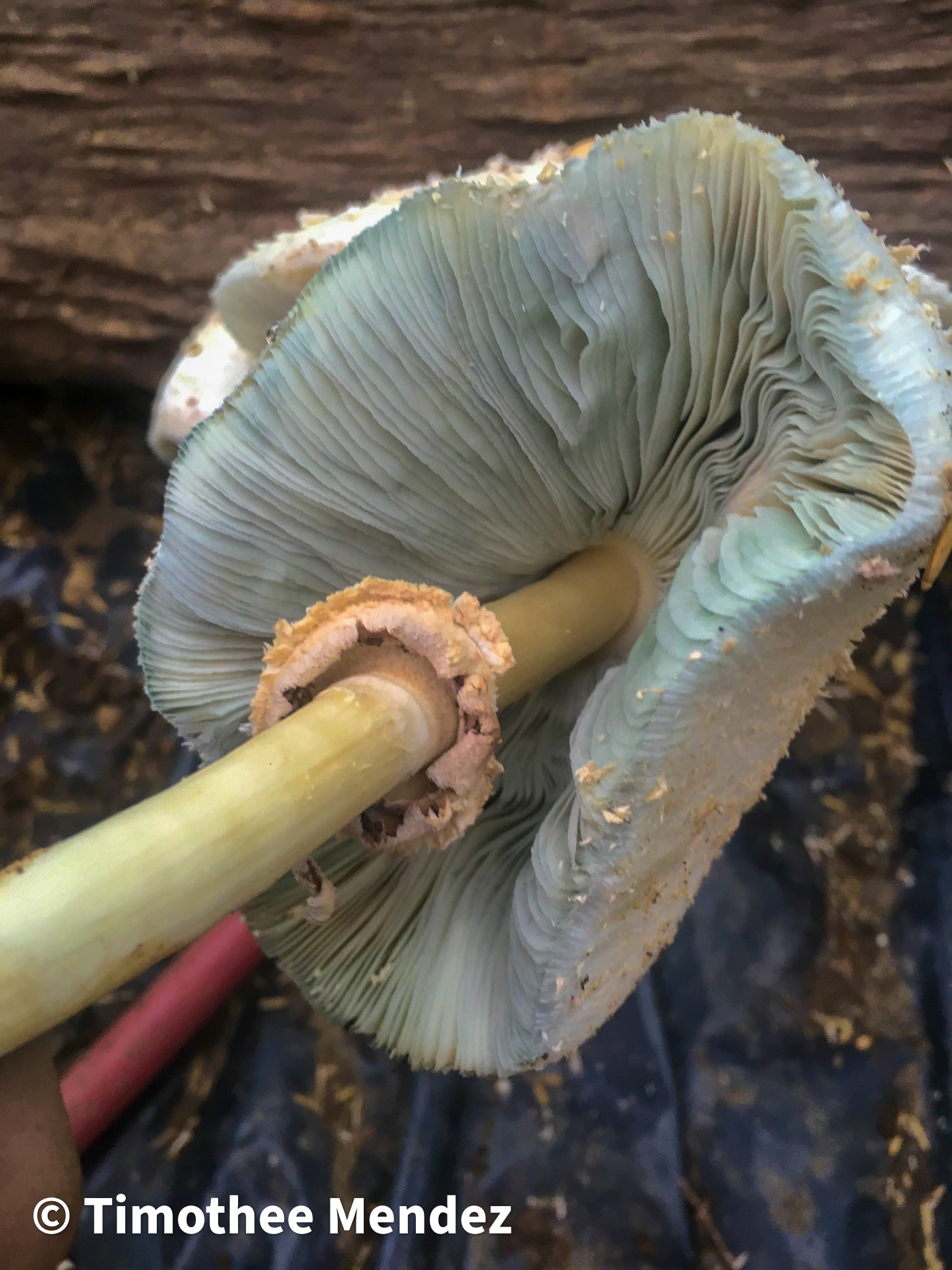
Chlorophyllum venenatum
This is a toxic species that resembles Shaggy Parasols but tends to grow in cespitose clusters with many stems growing from a single point. It tends to have darker scales and central scales that are larger and patchy. The bulb of this species is larger and much more pronounced. Not much is known about this species, and it’s pretty uncommon and maybe even absent from the Americas.
Regardless, stay on the side of caution when picking any type of parasol to make sure you don’t have this or other toxic Chlorophyllum species.

Deadly Amanitas (Amanita sp.)
These mushrooms have a similar umbrella-like shape and a ring, which could make some individuals confuse them with Parasols. The main differences are that Amanitas are typically smaller and don’t have true scales on their cap.
The cap surface on Amanita is typically smooth, occasionally with small patchy veil remnants (as is the case with Amanita muscaria). Amanitas also have a bulbous base with a cotton-veil.
Shaggy Mane (Coprinus comatus)
These might be mistaken for a Parasol, although Shaggy Mane Mushrooms they have a much different structure. They have a long-tall cap as opposed to an egg-shaped or spherical cap.
They may also often have an ink-like substance along the cap margin and are much more fragile. They also do not have the same textured stem as the Parasol.
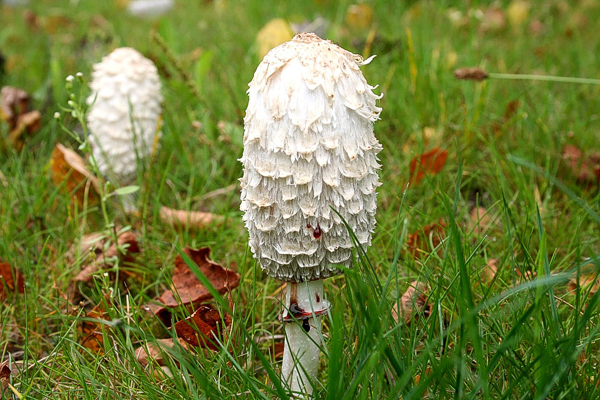
Lepiotas
Lepiotas is a large genus with many species, some of which can be potentially toxic. They have some similar features to the Parasol mushroom but are typically much smaller. They don’t usually grow larger than 10 cm in size. They also lack the textured stem of the parasol.
Where To Find Parasol Mushrooms
Parasol mushrooms occur in most parts of the world, particularly in northern latitudes, temperate climates, and mountainous tropical regions. True Parasols (Macrolepiota) are pretty much absent from the western United States, although there you can find Shaggy Parasols.
The general habitat is as previously discussed. Meadows, pastures, forest edges, sides of trails/roads, gardens, and both broadleaf and coniferous forests. They thrive in fertile soils with high quantities of organic matter and sufficient moisture/humidity.
- Eastern North America: From Florida and the rest of the Gulf States, up to the Great Lakes and the northeast, you can find Parasol Mushrooms. They are pretty abundant and commonly foraged in the Appalachians, near Lake Michigan, and in the Northeast. The abundance tapers down as you reach Canada although they still occur.
- Western North America: As previously mentioned, true parasols are pretty rare in the West. They’ve only been found near the coast in regions where they were likely introduced. Chlorophyllum species are much more common in the west and particularly common in urban landscapes, parks, and gardens. Macrolepiota has been reported in the southwestern Sky Islands and may occur in the Colorado front range.
- Europe: Parasol Mushrooms are hard to miss if you’re mushrooming in Europe during the right time of year. I’ve found them in pastures, woodlands, forests, and even in the middle of trails.
- Other Parts Of The World: Parasols are found throughout the southern hemisphere, including South America, Australia, and New Zealand. They can also be found in Africa and Asia. They can be found in Mexico and Central America as well.
When To Find Parasol Mushrooms
Parasol mushrooms are classic summer mushrooms across their range. Here’s when you can find them depending on your location:
- Northeastern North America: From July to November peaking around September.
- Southeastern United States: From May to November peaking around October.
- Gulf States: From August to December peaking around October. In Texas, there is also a smaller spring season from February to July that peaks around April. In Florida you can pretty much find them year-round but the season peaks in the winter around November.
- Mexico and Central America: Here the season is fueled by summer monsoons from June to October.
- Europe: In Europe, the season typically occurs in summer/fall from July to November. In areas with more mild winters, like Spain and Portugal, you can find them into December.
- Southern Hemisphere: In most of the southern hemisphere the season occurs from March to July. This is the case for Australia and for most of South America.
How To Harvest Parasol Mushrooms
When foraging anything from the wild, it is important to do so with respect. Not only for the local ecosystem but also for your local community. Don’t litter, cause erosion, or decimate spots that might be used by locals. I always adhere to leaving some for the animals, and if there’s enough, for the next pickers! Harvest with permission if it is required.
Before harvesting anything, do your best to properly ID this species in the field. Use a field guide, the internet, or draw from your memory. If you’re unsure, only harvest one to take back for further study, or take good pictures. New foragers may want to unearth the entire mushroom carefully to make sure it doesn’t have a cottony bulbous base like the toxic amanita lookalikes.
Generally speaking, the caps are considered the best part of the mushroom. For this reason, some people only collect the caps. I’ve eaten the stems, and they’re tasty, but definitely tougher and perhaps more difficult to digest. You can always dry them, powder them, and then add them to stews and other meals.
Some folks only pick the immature caps. These are still spherical/egg-shaped and are the best if you want to stuff them!
Since many people are only after the cap, one of the most common ways to harvest this mushroom is to simply snap the cap off by hand. Alternatively, you can pick the whole mushroom or cut the stem with a knife. While there are advocates who claim one or the other method is better, the few studies conducted on this matter show there is very little difference in the impact of cutting vs picking (1, 2). So you can do as you prefer, although consider following whatever practice is more accepted locally.
Before putting any mushrooms in your basket or bag, make sure to remove any dirt or debris from your mushrooms. This will keep them cleaner in the long run. It’s always recommended to forage mushrooms in a basket because it retains them in better condition compared to bags. If you do use a bag, use extra caution so as not to damage the mushrooms while walking.
Once you arrive at home, it is best to attend to your mushrooms immediately. They can last 2 or 3 days in the fridge if they’re in good condition, but it’s recommended to eat or process them as soon as possible.
Cooking Parasol Mushrooms
Parasol mushrooms are versatile and can be used in many recipes. You can easily replace any that calls for Button Mushrooms although the flavor and texture are distinct. Pasta, stir-fries, sauces, in-cream, or whatever dish you happen to be craving will probably make a good combo with these mushrooms. Of course, if you want to taste the true essence of this mushroom, go for something simple with minimal spices.
It is important to always cook your parasol mushrooms thoroughly. While they’re not known to be toxic raw, they will be difficult to digest and could make you ill. There’s a pretty high occurrence of people being sensitive to this mushroom, one partial reason for this is that people are not cooking them thoroughly. This is particularly true with Shaggy Parasols.
One of the most common European recipes for this mushroom is breaded and fried. Simply dip it into eggs, bread it, and then place it in a hot pan with oil. From my experience, you kind of need to use a lot of oil so the mushroom cooks thoroughly; if not, you end up burning the bread before the mushrooms are done. Also, simply grilling this mushroom over some hot-coals is also quite delightful.
Another popular recipe is stuffed parasol caps. Simply make a stuffing of choice with bread, cheese, nuts, dried fruit, meat, more mushrooms, or a combination of them all. Season it thoroughly and fill some young parasol caps. Place it in the oven until it’s been thoroughly cooked!
Preserving Parasol Mushrooms
There are many ways to preserve Parasol Mushrooms, but the best has got to be cooked and frozen. Simply slice and cook them in a pan with whatever seasoning you’d like. Once cooked, wait for them to cool and freeze them. Like this, you can simply integrate them into whatever recipe you’re making. Don’t freeze them without cooking, or else they’ll lose their beautiful texture!
You can dry the mushrooms, but they do lose a large majority of their flavor. Canning, pickling, and maybe even jerky could be some good methods to preserve them, although I haven’t tried these with Parasols.
Bon Appetit, and Enjoy!
Summer Mushroom Foraging
Looking for more edible wild mushrooms to forage this summer? These summer mushroom identification guides will help keep you busy!
- Puffball Mushrooms
- Shaggy Mane Mushrooms
- Reishi Mushrooms
- Turkey Tail Mushrooms
- Dryad’s Saddle
- Saffron Milk Caps
- Chanterelle Mushrooms
- Pigs Ear Mushrooms
- Honey Mushrooms
- Matsutake
- Boletes
- Hedgehog Mushrooms
- Lobster Mushrooms
- Black Trumpet Mushrooms
- Chicken of the Woods
- Beefsteak Mushrooms
- Coral Mushrooms
- Beefsteak Mushrooms
- Wood Ear Mushrooms
- Agaricus Mushrooms


